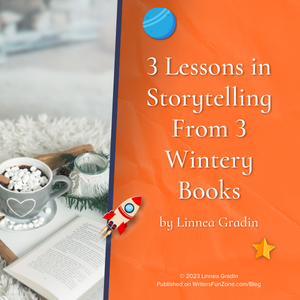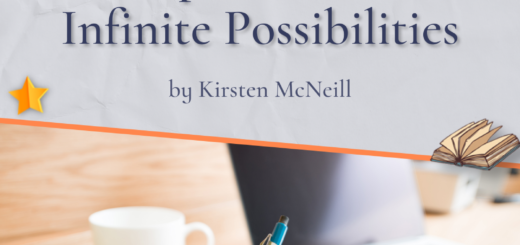3 Lessons in Storytelling From 3 Wintery Books by Linnea Gradin
 Let’s welcome back Linnea Gradin as she shares with us “3 Lessons in Storytelling From 3 Wintery Books.” Enjoy!
Let’s welcome back Linnea Gradin as she shares with us “3 Lessons in Storytelling From 3 Wintery Books.” Enjoy!
***
As darkness descends on the northern hemisphere, ‘tis the season to take a closer look at how winter settings and themes are utilized in literature.
Like any other season, winter offers unique elements for authors to employ to enhance their writing, giving them a setting full of symbolic meaning and inherent challenges.
So, in this article, I’ve taken it back to the basics by looking at 3 different books set during the colder months — 2 classics and 1 contemporary — to see what each one does well and what we can try to emulate in our own writing.
1. Moon of the Crusted Snow by Waubgeshig Rice
There has long been a tradition of using winter, with its snowy darkness, to create stakes in narratives, as in Jack London’s The Call of the Wild.
Similarly, in Moon of the Crusted Snow, the wintery setting of northern Canada becomes the backdrop to an apocalyptic vision as the Anishinaabe community try to survive without power and with dwindling food supplies.
In this extreme environment, the status-quo is shaken when strangers from the south arrive and members of the community start to turn up dead.
In this novel, the outer elements create high stakes and an atmosphere that propel the action forward, posing a threat both to the characters’ physical survival and the stability of the community.
This effect could be achieved in other landscapes too, of course, but here Rice makes setting meaningful by evoking the reader’s senses and raising the stakes — while touching on themes of isolation and resilience, not to mention settler colonialism.
2. The Ice Palace by Tarjei Vesaas
Another tool that is not exclusive to wintery tales but is highly effective is to let the setting reflect the emotional life of the protagonist.
In The Ice Palace, Norwegian novelist Tarjei Vesaas delivers a masterclass on how to do just that.
The story is centered around two young girls, Unn and Siss, who only meet for a brief day.
But the meeting is so profound that when Unn gets caught in a literal ice castle and disappears without a trace, Siss falls apart and locks herself up in her own mental ice castle, refusing to speak to anyone.
Here, the setting serves as a reminder of the cold, harsh realities of life and Versaas mines it for metaphors to capture the experience of loss, grief, and loneliness.
Winter is also used to mark the end of a cycle: the end of life. In much the same way, rainy skies can symbolize sadness, storms inner turmoil, or sunny days happiness.
This classic literary device, taught in most beginner creative writing classes, is a very effective way to show and not tell, and can be used on multiple levels, from building your whole novel around it or simply sprinkling it in individual scenes or sentences.
3. A Christmas Carol by Charles Dickens
Lastly, I couldn’t write this list without including Charles Dickens’ classic A Christmas Carol.
Fan or not, there’s no denying that we can learn a lot from Dickens’ craft and this short novella has plenty to unpack for the analytically-minded reader.
For example, by writing a wholly unlikeable character like Ebenezer Scrooge, Dickens creates the potential for a satisfying redemption arc that is perfect for the holiday season and its accompanying themes, such as regret, generosity, and moral responsibility.
This is a simple but powerful tool to get your readers invested in the story, but a note of warning: don’t make your character so unlikable that your readers lose all empathy for them or there’s no possible redemption.
Make sure that their choices and actions still make sense, even if we don’t agree with them.
Another technique that Dickens uses is repetition. This has many functions. It emphasizes Scrooge’s stubbornness, it creates rhythm and structure, builds tension, and, paradoxically, highlights Scrooge’s character development.
The pattern of three’s is subconsciously ingrained in most readers so by slightly tweaking each iteration of it, you can use this as a template to create a sense of progression without needing to rely too much on plot or action.
Psst! The holiday setting, specifically, often comes with loads of underlying tension that authors can use — from family drama to exploration of (and perhaps departure from) tradition.
There’s a lot more that we can learn from wintery reads, but here are just three examples of how you can read to write better. In the hands of a skilled author, winter settings can elevate a story, highlight themes, and evoke the reader’s senses. So browse your own library for wintery reads to look for motifs and techniques you can employ in your own writing as the year comes to an end.
***
ABOUT THE AUTHOR
![]() Linnea Gradin writes about writing and publishing over at Reedsy — a website that connects authors with freelancing publishing professionals and gives advice on everything writing and publishing-related, from how to design a book cover to the pros and cons of self-publishing vs traditional publishing.
Linnea Gradin writes about writing and publishing over at Reedsy — a website that connects authors with freelancing publishing professionals and gives advice on everything writing and publishing-related, from how to design a book cover to the pros and cons of self-publishing vs traditional publishing.






